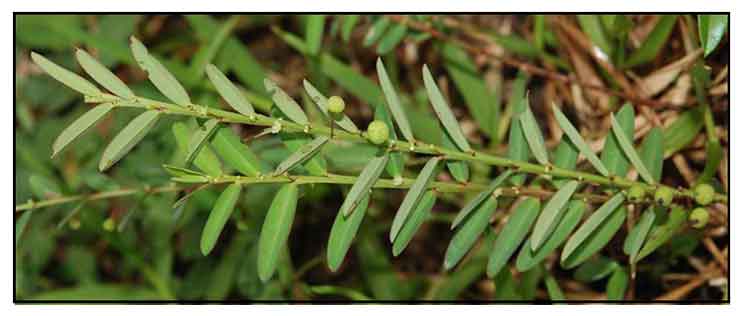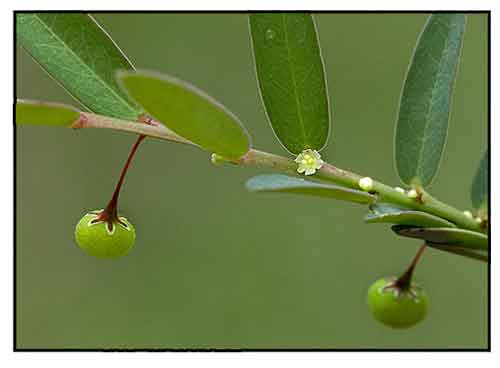 Gen info Gen info
- Phyllanthus is the largest genus in the plant family Phyllanthaceae with a diversity of growth forms that include annual and perennial herbs, shrubs, climbers, floating aquatics, and pachycaulous succulents. The number varies widely, from 750 to 1200. (v)
- Phyllanthus was first described by Carl Linnaeus in 1753, but the type was not designated.
 Botany Botany
Kaya-an is a slender, erect, simple or slightly branched, smooth, annual herb, 20 to 50 centimeters in height. Stems are flattened, and usually purplish. Leaves are two-ranked, oblong-linear, 1.5 to 3 centimeters long, and 6 to 9 centimeters wide. Flowers are very small, solitary, and borne on the axils of the leaves. Capsules are smooth, depressed-globose, and 3 to 3.5 millimeters in diameter.
Distribution
- Native to the Philippines.
-
Common throughout the Philippines, in open grasslands, fallow rice lands, etc., at low and medium altitudes.
- Also native to Assam, Australia, Bangladesh, Borneo, Cambodia, Caroline Is., China, Cook Is.,Fiji, Hainan, Himalaya, India, Jawa, Laos, Lesser Sunda Is., Marianas, Myanmar, Nansei-shoto, Nepal, New Caledonia, New Guinea, New South Wales, Nicobar Is., Niue, Northern Territory, Pakistan, Queensland, Samoa, Society Is., South Australia, Sri Lanka, Sulawesi, Sumatera, Taiwan, Thailand, Tonga, Tubuai Is., Vanuatu, Vietnam, Wallis-Futuna Is.
 Constituents Constituents
- Phytochemical screening yielded an abundance of phenolics, tannins and flavonoids.
-
Leaf yielded phenolics, tannins, flavonoids, sugars, saponins, amino acids, volatile oil.
- Study of chemical composition of leaves yielded four compounds: vanillin, β-daucossterol, β-sitosterol and rutin.
(10)
- Phytochemical studies have yielded: tannins (virgatyne, virganin, nodignan), ellagitannins (geraniin), flavonoid sulfonates (galanin-8 sulfonate, galanin-3-O-beta-D-glucoside-8-sulfonate, kaempferol-8-sulfonate), and acid (indole-3-carboxylic acid).
(20)
- Phytochemical screening of various extracts of leaf, shoot, and root yielded: alkaloids (LSR), anthocyanins (LSR), catacholic compounds (SR), coumarins (L), dihydrochalcones (LSR), flavonoids (LSR), flavones (LSR), gallic tannins (L), glycosides (LSR), phenols (LSR), proteins (LR), saponins (L), steroids (L), triterpenoids (LSR). (23)
- Study f an EtOH extract of whole herb of P. virgatus isolated a new lignan,
(−)-7,8-cis-8,8‘-trans-7‘,8‘- trans-7-(3,4-(methylenedioxy)phenyl)-7‘-(3‘,4‘-dimethoxyphenyl)-8,8‘-bis(methoxymethyl)tetrahydrofuran, named virgatusin (1), along with seven known lignans and indole-3-carboxylic acid. (24)
Properties
- Studies have shown anti-inflammatory, antioxidant, antiviral, anthelmintic, antidiabetic, anti-hyperlipidemic, antifungal, hepatoprotective properties.
Parts used
Leaves, flowers, seeds.
Uses
Folkloric
- In the Philippines, the Manobos of Mindanao use decoction of leaves, flowers, and seeds for treatment of cancer. (33)
-
Hindus use equal parts of the fresh leaves, flowers, and fruit, and cumin seeds with sugar, made into an electuary for the cure of gonorrhea - a teaspoon is given twice daily.
- Bruised fresh leaves, mixed with buttermilk, used as a wash to cure itches in children.
- In Thailand, used for liver ailments, jaundice, diabetes, gonorrhea.
- In India, leaf juice used for jaundice and diabetes.
- In Chota Nagpur, roots is used as external application for mammary abscesses.
- In China, herb extract fed to children suffering from malnutrition due to worm infestation. (20)
- In India, the Gond tribe use the plant as antiseptic and anti-inflammatory. (20)
- In India, Bhils and its subtribes use aqueous extract of whole plant without fruit for fever: two teaspoons twice daily for 2-3 days. (28)
- In Vanuatu, roots used to facilitate childbirth. (29)
Studies
• Antioxidant / Anti-Inflammatory / Phenolic Contents: P. simplex ether extract showed significant concentration-dependent scavenging of DPPH, hydroxyl and superoxide radicals. It also showed significant inhibition of NO production and significant inhibition of carragennan-induced paw edema. Results show significant antioxidant and anti-inflammatory activities which was attributed to its high phenolic content. (1) In this study, the highest percentage of DPPH radical scavenging activity was observed in gallic acid rich sub-fraction of P. virgatus. The gallic acid content may also be reason for its hepatoprotective activity. The higher bioactivities of P. virgatus compare to other herbaceous phyllanthus species and may be attributed to the antioxidant activity of gallic acid and other phenolics present. (21)
• Anti-Diabetic / Antioxidant: Study of MeOH and aqueous fractions of PS demonstrated significant antioxidant and antidiabetic potential and suggest therapeutic value in diabetes and related complications. (2)
• Anti-Cancer / Antioxidant / Roots and Rhizomes: Study of ethyl acetate and ethanolic extracts from the roots and rhizomes of P. simplex against DAL and EAC cell lines showed significant anti-cancer activity, with the alcoholic extract showing more cancer dead cells than the EA extract. (3)
• Anthelmintic: Study showed the ethanolic extract was more potent than other extracts against Indian round worm Pheretima posthuma. The comparison drug was piperazine citrate. (5)
• Anti-Inflammatory: Ethanolic and acetone extracts from the whole plant showed significant activity at the doses of 400 mg/K with inhibition of both acute and sub-acute anti-inflammatory models. (6)
• Anti-HBV Effect: Study showed the water and alcohol extract of P. simplex had an inhibitory effect on the HBsAg. (7)
• Antioxidant / α-Amylase Inhibitory Property / Antidiabetic: A methanol extract of P. virgatus exhibited strong antioxidant and oxidative DNA damage protective activity, correlating with its phenolic content. Also, the ME strongly inhibited the α-amylase activity. Results provide basis for the potential future use for the treatment and management of diabetes as well as related conditions of oxidative stress. (11)
• Antioxidant / Cytotoxicity / Mitochondrial Effect: In a comparative study of three Phyllanthus species, the methanolic extract of P. virgatus showed the highest free radical scavenging activity and highest inhibition of peroxidation. Also, the extract showed the strongest cytotoxic effect to human hepatoma HepG2 cells. The extract impaired hepatic energy metabolism by acting as mitochondrial uncoupler and inhibitor of oxidative phosphorylation. The mitochondrial effects may be intimately involved in the cytotoxic action on HepG2 cells. (12)
• Hepatoprotective / Cd2+-Induced Loss of Mitochondrial Membrane Potential: A methanol extract of P. virgatus was shown to block the collapse of mitrochondrial transmembrane potential induced by CdCl2 in a dose-dependent manner. Results postulate the extract may act by blocking Ca2+ uniporter to impeded Cd2+ influx into the mitochondria and/or by inhibiting Cd2+-induced PTP opening. (13)
• Hepatoprotective / Antioxidant: Study evaluated the hepatoprotective and antioxidant activity of P. virgatus against CCl4 and paracetamol induced hepatotoxicity in male wistar rats. Results showed significant in-vivo/in-vitro antioxidant activity in different models and significant (p<0.01) hepatoprotective activity. (15) Study of methanolic extract at dose of 200 mg/kg showed significant decrease in levels of liver enzmes, suggesting hepatoprotective activity against CCl4 induced hepatocellular injury. Acute toxicity study showed no mortality at single doses of 1000 and 2000 mg/kg, with no signs of behavioral changes except for increase in urination, suggesting safe usage of the extract at doses of 100 and 200 mg/kg. (32)
• Antidiabetic / Antihyperlipidemic / Antioxidative: Study evaluated a methanolic extract and its purified fractions on hyperglycemia and hyperlipidemia in streptozotocin induced diabetic rats. Results showed a strong anti-diabetic and hypolipidemic impact of the extract and fractions coupled with potent antioxidative property. (16)
• Antianaphylactic / Leaves: Study evaluated the effect of a hydroalcoholic extract of leaves on experimental anaphylactic conditions using passive cutaneous anaphylaxis on different rat models. Results showed a dose dependent beneficial effect on leakage of Evan blue dye in skin challenged with antigen. The antianaphylactic activity may be due to its membrane stabilizing potential, inhibition of antigen induced histamine release and inhibition of release of various inflammatory mediators. (17)
• Virgatusin / Antifungal: (-)-Virgatusin is a lignan isolated from Phyllantus virgatus used as a herbal drug for liver problems. Study of optically pure (-) - and (+)-virgatusin, a tetra-substituted tetrahydrofuran lignan, showed high antifungal activity against Colletotrichum lagenarium. (18)
• Pharmacologic Effects of Major Phytochemicals: Phytochemical studies have yielded major phytochemicals with pharmacologic effects: Lignans: niranthin, nirtetralin, hinokinin (antiviral) and virgatusin (antibacterial); Ellagitannin: geraniin (antiviral). (20)
• Comparative Study on Antioxidant and Cytotoxic Activities / P. virgatus and P. amarus: Study evaluated the antioxidant activity and cytotoxicity of Phyllanthus virgatus crude extract compared to P. amarus. Antioxidant activity was measured by DPPH scavenging and antilipid peroxidation assays. Cytotoxicity was assessed on human hepatoma HepG2 cells. The extract of P. virgatus yielded more phenolic compounds than P. amarus. The hydromethanolic extract of P. virgatus showed stronger antioxidant and cytotoxic action than P amarus. The stimulation of HepG2 cell respiration by P. virgatus extract suggests the extract alters mitochondrial function, which may play a role in the plant's cytotoxicity. (22)
• Effect on Weed Species / Weed Control: Study evaluated the potential of allelochemicals from P. virgatus to inhibit plant germination and growth using 10 common weed species. An aqueous extract of P. virgatus (leaf/stem/fruit) was mixed with agar to produce a 5% FW/v substrate concentration. Seeds of Apium leptophyllum, Avena fatua, Bidens pilosa, Chenopodium album, Echinochloa crus-galli, Lolium rigidum, Parthenium hysterophorus, Raphanus raphanistrum, Sonchus oleraceous and Urochloa pannicoides were placed on agar and germinated under controlled conditions. Extract caused significant reduction in germination of some weed species. Shoot growth was significantly reduced in most weed species. Root growth was severely affected in all species that survival would have been unlikely if the extract environment was maintained. (25)
• Hypoglycemic Effect / P. virgatus and Juniperus phoenicea / Leaves: Study evaluated the antihyperglycemic effect of alcoholic extracts of P. virgatus and J phoenicea leaves in STZ-induced diabetic Sprague-Dawley rats. Results showed the extracts at doses of 400 mg/kbw per day significantly improved lipid profile, decreased blood glucose and MDA, but increased levels of insulin, GSH, and SOD along with alleviation in histopathological changes in the pancreas of diabetic rats. Results suggest glucose lowering effects and potential for reduction of hyperglycemia-related complications. (26)
• Antibacterial / Shoots: P. virgatus ethanol extract of shoots showed potential antimicrobial activity against all four test pathogens viz., E. coli, Pseudomonas spp., S. aureus, and Klebsiella spp.; the methanol extract was more effective against S. aureus. (27)
• Antioxidant / Leaves: Study evaluated the in vitro antioxidant activities of ethanol extract of leaves of P. virgatus. Results showed dose dependent scavenging effect on DPPH, ABTS, reducing power, hydroxyl radical, NO, superoxide, lipid peroxidation, and H2O2 assays. (30)
• Antidiabetic / Antioxidant / Seeds: Study evaluated the antioxidant and antidiabetic potentials of seed extract of P
Availability
Wild-crafted.
|

![]()






